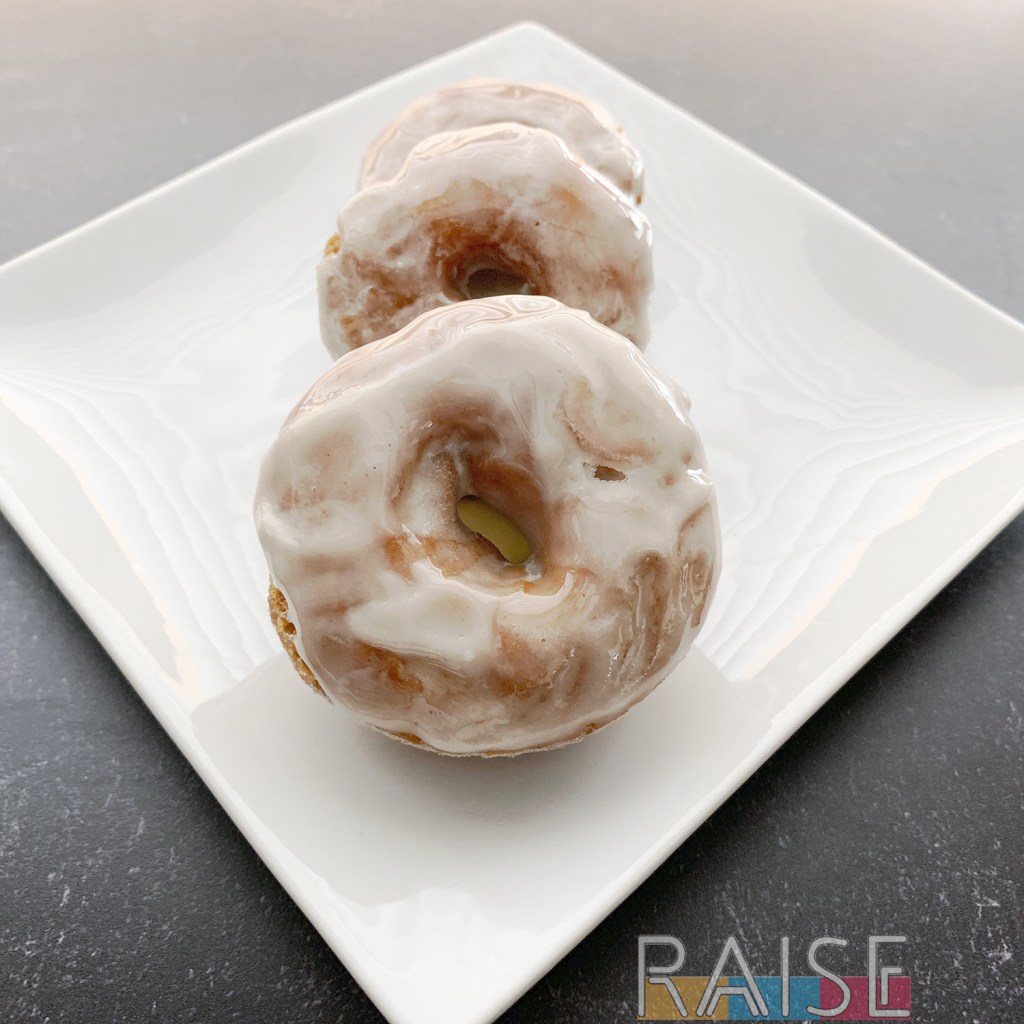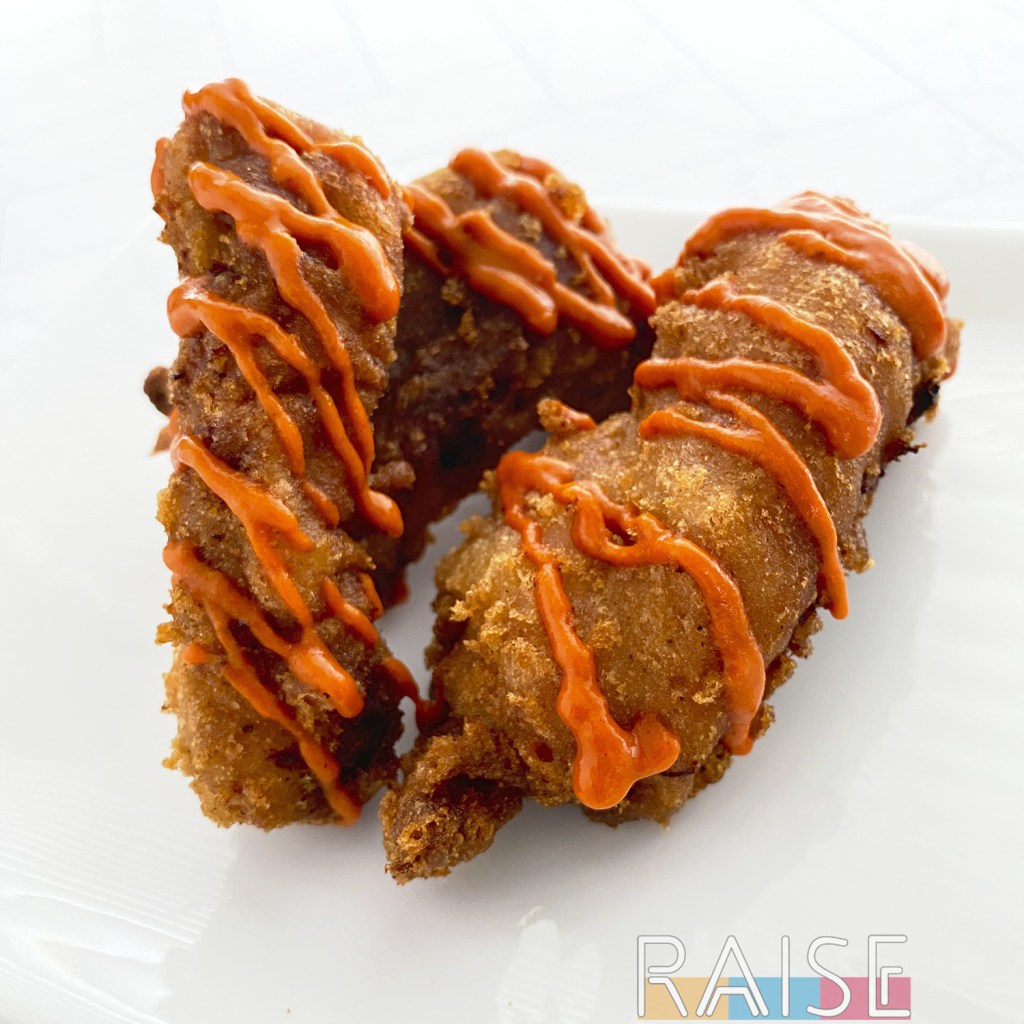If you’re reading this, you’re wanting to know if good old French fries are gluten free and the short answer is MAYBE. There are a lot of variables to account for, so let’s look at the main categories, then I’ll give you a lot of details.
- Are homemade French fries gluten free? YES. You can make homemade French fries gluten free.
- Are frozen French fries from the grocery store gluten free? MAYBE. It depends on the brand and how the potatoes are processed.
- Are French fries at fast food restaurants gluten free? MOSTLY NO.
- Are French fries at mom and pop diners gluten free? MAYBE. It depends on the restaurant staff, their ingredients, and their quality control.
Gluten in Batters
By default, fried foods are not gluten free, and you’ll need to investigate each option you want to try carefully. This is true of store bought fried foods and fried foods at restaurants. The first thing you need to know: what’s in the batter (sometimes called coating). Was it made with wheat flour or any other gluten-containing ingredients? From there, you’ll want to know about the fryer situation (more on that later).
Next, you’ll want to look out for things like “gluten free beer-battered fries”. This is a perfect example of how some well-meaning restaurants may drop the ball. Beer is a hidden source of gluten not everyone knows about. If an establishment uses a gluten free flour blend for their fried foods, but then adds gluten-containing beer to the batter, it’s no longer gluten-free.

How to Make a Safe Choice
Making a safe choice when selecting gluten-free foods is almost like a muscle you’ll work on building over time. The more you talk with manufacturers, the more you’ll have a better understanding of how to avoid gluten-containing foods and cross contact with gluten via gluten contamination. Through your journey, you’ll even meet some people who will say “a little gluten won’t hurt”, and then you’ll find yourself advocating for the community.
In the meantime, first, remember that no two people are the same. Some people can eat French fries that were made in a fryer alongside gluten ingredients whilst others have found that the only way they can eat fried foods is if they’re from a dedicated fryer.
Second, know yourself and your condition. For example, someone with Celiac Disease may need to be a lot more strict with their diet when compared to someone with Non-Celiac Gluten Sensitivity (NCGS) who has a higher tolerance for trace amounts of gluten and follows a “reduced gluten” diet rather than a strict gluten free diet.
No matter which of these applies to you, before eating French fries or any other fried foods at a restaurant you’ll want to double check and find out if they’re using separate gluten-free fryers, or if there’s a high chance of cross contact from shared equipment.
Ultimately, what’s safe for you is going to be unique to you, so use your experience to make a wise choice. For one of my kids, shared equipment is a no-go because they’ve had severe allergic reactions in the past when eating food made on shared equipment. For another one of my kids, shared equipment isn’t an issue and I only need to look at the ingredient label to confirm their allergen isn’t one of the ingredients.
If you’re new to all of this, I strongly encourage you to get the apps Allergy Eats, Fig, Find Me Gluten Free, and Spokin. These apps can help you find new packaged foods and restaurants to try, plus, there are user generated reviews so you can see how other people fared.

Are the French Fries at Fast Food Restaurant Chains Gluten Free?
Let’s take a look at some of the big fast food chains here in the United States, which is where I’m located. I was able to dig around online to find this information, however, it could all change at any time. Plus, I need you to always remember that in-person practices and procedures at fast-food restaurants may not be up to your standards (where cross-contact is concerned).
For those who are wondering if the fries at Red Robin are gluten free or if the fries at Burger King are gluten free and and other fast-food chains, you’ll find a list of the most recent list of ingredients that I could find, and we’ll assess if the fries are good for anyone following a gluten free diet.
Chick-Fil-A Waffle Fries
On their website in an allergen statement, it’s implied that the Chick-Fil-A waffle fries are gluten free, however, I couldn’t learn enough about them to tell you all the true gluten-free status of these fries.
I did however call a local branch of Chick-Fil-A, and the gentleman told me they use a dedicated fryer that’s just for the fries. I won’t like though, he didn’t seem to certain about this? Let’s just say, if you’d like to eat the fries from Chick-Fil-A, I strongly suggest visiting your local branch and talking directly with a manager.
Ingredient List: Potatoes, canola oil (high oleic canola oil with dimethylpolysiloxane added as an anti-foaming agent), vegetable oil (canola, palm, soy), modified food starch (corn, potato, tapioca), leavening (disodium dihydrogen pyrophosphate, sodium acid pyrophosphate, sodium bicarbonate), rice flour, salt, dextrose, xanthan gum, dextrin, pea starch, disodium dihydrogen pyrophosphate (to maintain natural color)
Burger King French Fries
Based on the allergen statement from Burger King, I’d say that no, Burger King French fries are not gluten free.
Ingredient List: Potatoes, Soybean Oil or Canola and Palm Oil, Modified Potato Starch, Rice Flour, Potato Dextrin, Salt, Leavening (Disodium Dihydrogen Pyrophosphate, Sodium Bicarbonate), Dextrose, Xanthan Gum, Sodium Acid Pyrophosphate added to preserve natural color.
*Prepared in fryer used for product containing wheat.
Bottom Line: Since they disclose the shared fryer upfront, I’d say Burger King French fries are not gluten free.
Five Guy’s French Fries
According to the allergen statement on the Five Guys website, their fries don’t contain wheat, gluten, milk, eggs, and several other major allergens.
Five Guys Style French Fries Ingredient List: Potatoes, Refined Peanut Oil, Salt.
Five Guys Cajun Style French Fries Ingredient List (supplier M): Potatoes, Refined Peanut Oil, Salt, Cajun Seasoning (Garlic, Spices [Including: Paprika, Oregano, Red Pepper] Salt, Onion).
Five Guys Cajun Style French Fries Ingredient List (supplier S): Potatoes, Refined Peanut Oil, Salt, Cajun Seasoning (Garlic, Spices [Including: Celery, Red Pepper], Paprika, Canola Oil, Silicon Dioxide (to prevent caking)).
In addition to the ingredients and allergen information online, Five Guys has a pretty clear statement about cross contact risk, and that they do their best to train their staff but make no guarantees of the free-from status of their products. Bottom line: The French fries at Five Guys seem gluten free on the surface, but you’ll have to eat here at your own risk. Their manufacturer statement, whilst thorough, makes me wonder if they’ve had issues in the past.
McDonald’s French Fries
Whilst finding the ingredients for McDonals’s fries wasn’t easy, I did appreciate their transparency. Upfront, they tell you that they make no claims that their products are gluten free, or safe for those with religious needs (Kosher etc.). They have a few other upfront disclosures, and it’s just nice to see that they’re not trying to gloss over it with double speak.
Ingredient List: Potatoes, vegetable oil, (canola oil, hydrogenated soy bean oil, natural beef flavor [wheat and milk derivatives]*, citric acid 0preservative]), dextrose, sodium acid pyrophosphate (maintain color), salt. Prepared in vegetable oil (Canola oil, corn oil, soybean oil, hydrogenated soybean oil with TBHQ and citric acid added to preserve freshness). Dimethylpolysiloxane added as an antifoaming agent. Contains Wheat and Milk.
Bottom Line: Since McDonald’s fries contain wheat, they are not gluten free.
Red Robin French Fries (Steak Fries)
Ingredient List: Potatoes, Canola Oil, Palm Oil, Cottonseed Oil, Disodium Dihydrogen, Sodium Acid Pyrophosphate, Dextrose, Frying Oil: [ Liquid And Hydrogenated Soybean Oil; TBHQ And Citric Acid Added To Protect Flavor; Dimethylpolysiloxane; An Anti-Foaming Agent Added ]
Red Robin Seasoning: Salt, Dried Cane Syrup, Sea Salt, Spices, Black Pepper, Celery Seed, Cumin, Oregano, Sage, Garlic, Onion, Tomatoes, Paprika, Yeast Extract, Natural Smoke Flavor
Cross Contact: Milk, Eggs, Soy, Wheat, Fish, Shellfish
Bottom Line: With that disclosure, Red Robin steak fries (French fries) are not gluten free.
Red Robin Sweet Potato Fries
Ingredient List: Sweet Potatoes, High Oleic Canola Oil, Canola Oil, Sunflower Oil, Corn, Potato, Tapioca, Sugar, Rice Flour, Corn Starch, Dextrin, Spice, Salt, Oleoresin Paprika, Xanthan Gum, Disodium Dihydrogen Pyrophosphate, Sodium Bicarbonate, Frying Oil: [ Liquid And Hydrogenated Soybean Oil; TBHQ And Citric Acid Added To Protect Flavor; Dimethylpolysiloxane; An Anti-Foaming Agent Added ] Sea Salt: Sea Salt
Cross Contact: Milk, Eggs, Soy, Wheat, Fish, Shellfish
Bottom Line: With that disclosure, Red Robin Sweet Potato fries are not gluten free.
Wendy’s French Fries
Whilst their fries have the largest ingredient list, I appreciate that Wendy’s discloses the shared fryer up front.
Ingredient List: Potatoes, Vegetable Oil (Soybean, Canola, and/or Cottonseed Oils), Modified Food Starch (Potato, Corn, Tapioca), Rice Flour, Dextrin, Salt, Leavening (Disodium Dihydrogen Pyrophosphate, Sodium Bicarbonate, Monocalcium Phosphate), Dextrose, Xanthan Gum, Disodium Dihydrogen Pyrophosphate (To Promote Color Retention). Cooked In Vegetable Oil (Soybean Oil, Vegetable Oil [May Contain One Or More Of The Following: Canola, Corn, Or Cottonseed], Hydrogenated Soybean Oil, Dimethylpolysiloxane [Anti-Foaming Agent]). Seasoned With Sea Salt. Cooked in the same oil as menu items that contain wheat, milk, and fish.
Bottom Line: Since a shared fryer is used, Wendy’s french fries are not gluten free.

How to Find Out if Dining Establishments Serve Gluten Free French Fries
Know this up front: it’s a bit of a process, and even if you find the information online, that info can’t account for the restaurant staff and the other in-person variables that can happen from one establishment to the next.
- Visit the restaurant’s website and look for a menu and/or list of ingredients (you may need to use the search box on their website).
- Find the list of ingredients for the French fries.
- Assess the ingredients.
- Look for any additional information on shared fryers *if* it looks like the French fries are gluten free.
- Call the restaurant to talk with a manager to confirm the information you’ve found.
With these five steps, you should be able to figure out if the French fries are gluten free, and if the staff will be able to serve you. However, you’ll need to always remember: cross-contact can happen so easily, and a lot of the restaurant staff will be young, and a lot less allergy aware.
Eating out with Celiac Disease and food allergies comes with a HUGE risk, so know that you’re taking that risk. Weirdly, I think sky diving is actually safer (been there, done that, it was pretty cold actually).

Shared Fryer & Dedicated Fryer Details
No matter what type of local restaurant you plan to visit (farm to table, fine dining, tiny diner, etc.), it’s important to know if the deep fryer is a shared fryer or a dedicated fryer. Some people with a gluten intolerance can handle shared fryers, but the only way for fried foods to be truly Celiac safe it so be made in a dedicated gluten-free fryer.
Shared Fryer: This is a single deep fryer that fries all of the fried foods on offer. It can fry meat, fish, vegetables, and even desserts. All types of batters are in this fryer. If the restaurant uses batters that have gluten-containing ingredients, then the fryer’s oil is contaminated with gluten. These food particles can transfer to “gluten free” items if they’re fried in the same oil. Those following a strict gluten-free diet should not eat foods made in a shared fryer.
Dedicated Gluten-Free Fryer: This is a deep fryer that only fries the gluten free battered foods on the menu. It can still fry a range of proteins, vegetables, and desserts (so if you’re vegan, it could contain trace amounts of animal-based ingredients). However, no gluten or wheat-containing foods are processed in this fryer, and the foods cooked in this oil are gluten free (assuming the rest of the supply chain and handling process was truly gluten free).
It’s becoming a bit more common to find restaurants that offer separate fryers, but we still have a long way to go. Restaurant equipment can be an expensive investment for owners, and require a lot of upkeep, so anytime you see a dedicated fryer, be sure to have so much appreciation.

Cross Contact: What Is It?
Cross contact, which some people incorrectly but also technically correctly call cross contamination, is something everyone with a food allergy needs to know about. It’s important that you use the terms that are used in the food service and food manufacturing worlds, not how you’ll see people use it on the internet. If you don’t use it properly then try to communicate, professionals will be confused.
Cross Contact: This refers to allergens specifically. If a chef uses a spoon in the gravy containing flour (wheat), then transfers the spoon to the gluten free sauce to sample. In this case, a pathogen was not transferred because the gravy is cooked. An allergenic protein however was transferred.
Cross Contamination: This refers to pathogens, bacteria, and food borne illnesses.
Example: a chef places raw chicken on a cutting board to prep it for service. After completion, raw celery which will be served raw is placed on the same cutting board. There’s contamination from the raw chicken and can cause a food borne illness via the celery that touched the board.
The issue with these terms is that *technically*, cross contact is indeed cross contamination. If you eat something contaminated with wheat/gluten, it causes a food borne illness in you. Yet, that’s where we have to focus on the terms pathogen and allergen. That will be the defining feature of these cross terms.
Now that you know the difference, make sure you use the right term when you communicate with companies and restaurants. Chefs and wait-staff especially will be confused if you use the wrong terms because they’ve been trained with pathogen vs allergen.
Don’t Ask Example: Is there a risk of cross-contamination with gluten?
Do Ask Example: Is there a risk of cross contact with gluten?
In the case of gluten-free fries (made with potatoes or sweet potatoes), you’ll want to ask about possible cross-contact with wheat flour, gluten proteins, and gluten-containing ingredients. This can happen via shared prep stations, poor staff training, shared fryers and other cooking equipment, etc.
If you’d like to read a lot more about cross-contact, all the ways it can happen, and how to prevent in your own home, check out this article.
Gluten Free Fried Food Recipes
I’ve got amazing fried food recipes on RAISE (membership website) that are gluten free, dairy free, egg free, and more. For some of you, your best bet on having safe options is deep frying at home, rather than eating fried foods at restaurants. Know that the taste testers are in love with these recipes, and I hope you make them because wow are they delicious.
- The Best Gluten-Free Fried Chicken
- Yeast Free, Truly Corn Free Fried Donuts (filled)
- Gluten Free Vegan Fried Eggplant
- Easy Grain Free Fried Pork Strips (my kids said I should open a restaurant and sell *just* these)
 |
 |
 |
 |
Answering Your Gluten Free French Fries Questions
Are onion rings gluten free?
That’s going to depend on the manufacturing process of the onion rings. First, is there gluten in the batter? If so, no, they aren’t gluten free. Next, how are they fried? If they’re made in a dedicated fryer, and have a gluten free batter, then yes, the onion rings are gluten free.
In restaurants, most onion rings are fried in a shared fryer with gluten-containing ingredients, rendering them not gluten free, and not safe for those with Celiac Disease.
Are tater tots gluten free?
Store bought tater tots have a high chance of being gluten free. You’ll want to read the ingredient label carefully, and also see if there’s any information about shared manufacturing equipment. You can also check the brand’s website for more details.
In restaurants, depending on how the tater tots are cooked, they might be gluten free. Many tater tots are oven baked, and if that’s the case, as long as the restaurant is using gluten free tots, they should be able to prepare them safely for you. However, if the tots they use have gluten-containing ingredients, then it’s not an option for you.
Inherently though, tater tots are generally a food you can find gluten free, and you can also make them from scratch at home to be gluten free.
Are chicken nuggets gluten free?
At restaurants, no, chicken nuggets most likely aren’t gluten free. You can find them, but you’ll want to start by looking for a dedicated gluten free restaurant. If there aren’t any in your area, look for a restaurant that has a dedicated gluten free fryer and start there.
With store bought chicken nuggets, there are a few brands that are indeed gluten free, and I’ve heard mixed reviews. If you’re willing to put in the elbow grease, you can easily make gluten free chicken nuggets at home.
Are chicken tenders gluten free?
If we’re talking about at a restaurant, no, chicken tenders are most likely not gluten free. That’s going to be from the ingredients in the batter to the most likely shared fryer. Now, there is a chance that a restaurant has gluten free chicken tenders, but I’d look for them at a specifically gluten free restaurant first and foremost.
If we’re talking store-bought, yes, you can find chicken tenders made with gluten-free ingredients.
At home, you can always make chicken tenders that are gluten free, and create really cool flavour profiles that you won’t be able to find in stores and restaurants.
What are gluten-free burgers exactly?
Usually, the actual burger patty doesn’t contain wheat or gluten. Instead, it’s the buns and some condiments that are the issue. In the case of gluten-free burgers, the first big difference is are gluten free buns that will be used. At a lot of restaurants, they order cases of frozen gluten free buns that are individually wrapped, then open it when an order is placed. Remember, the gluten free buns are in a kitchen where food particles containing wheat and gluten are present, so cross contact will always be a risk.
From there, they may have a gluten free BBQ sauce (or other GF sauce) that they use on the gluten-free burgers. They’ll also avoid any processed cheeses that contain wheat or gluten.
Depending on the type of restaurant and the quality of their base ingredients, there may be several changes that are made, or it may just be the buns. If you have concerns, always call the restaurant and talk to a manager or chef and ask about each of the components on the burger.
How can I find out which menu items are gluten free at fast food restaurants?
Many restaurants here in the United States and all over the world now have an allergen menu (or gluten-free menu at some restaurants) available on their website. The best way to find out which menu items might be a good fit for you is to start there.
Once you’ve reviewed the allergen menu, call the establishment. A lot of these fast food restaurant chains have locations all over the country (or world) and each location may handle things differently (think cross contact).
Call and ask about the gluten-free options you’re considering so you can then make an informed decision.
When I make fries at home, what’s the best temperature for deep frying?
Usually 350f/175 is going to be the best temperature, however, it’s really important that you make sure your frying oil is maintaining that temperature. When the oil temp is too low, the foods can absorb more oil and have an unpleasant greasy texture.
An instant read thermometer is a great way to monitor the temperature, and if frying at home is something you want to do regularly, get a proper counter top deep fryer. I have one, and zero regrets. ZERO.
Will frying food at home in olive oil taste good?
I’ve used olive oil as a frying oil in the past, and there were no complaints. You’ll want to make sure you look into the smoke points of different oils and not go over the smoke point for the best quality though.
Olive oil does have a lower smoke point when compared to something like beef tallow, but if you’re frying at the average temperature of 350f/175, you’ll be fine. When it comes to the taste, the only thing that really matters is what you think. I know not everyone loves the taste of olive oil. Dab your finger in a little and taste it. What do you think?
If you don’t like the taste, I’d suggest looking into tiger nut oil (tuber, not a tree nut), grass fed tallow, organic sunflower seed oil, and avocado oil as options. These can have less pungent tastes and you may like them better.
Also, huge tip on making fries at home: get yourself a restaurant grade french fry cutter that mounts to the wall. I have the type that they use at In-n-Out Burger and it made oven baked fries and deep fried fries a breeze when my kids were growing up.
When making oven baked fries, should I cook them on parchment paper?
For homemade oven baked fries, I actually skip parchment paper and bake the fries on oil directly on the tray. You’ll want to add a bit of oil to a large baking tray, then tilt the tray around to let the oil go all over. Then, place your cut fries on the tray in a single layer. For the best crispy results, the sides should not be touching.
I usually bake fries at 400f or 425f depending on how large they are. My bake time is 20 – 25 minutes, and my kids like them crispy, so I try to make sure the bottoms are nice and brown. On the oil, don’t use so much that the fries are swimming in oil and are poached, but you can’t use so little that it evaporates and the fries burn. As you make these again and again, you’ll have a good feel for how much oil to use.
For extra flavour, you can use bacon drippings instead of oil to cook the fries. My kids think this is best thing since sliced bread, or a Nintendo Wii.






